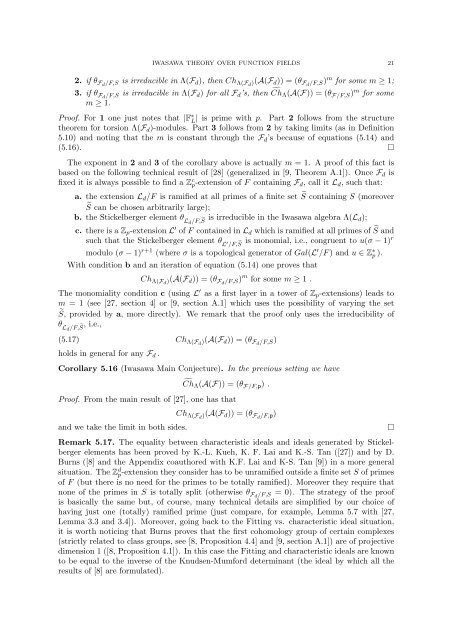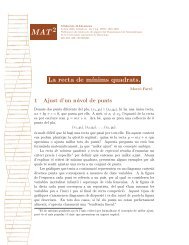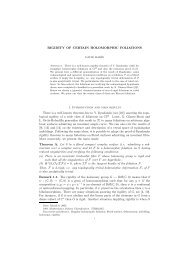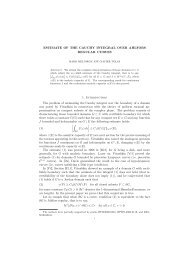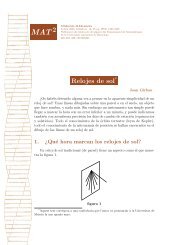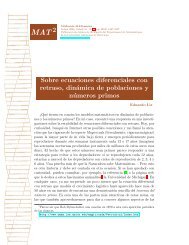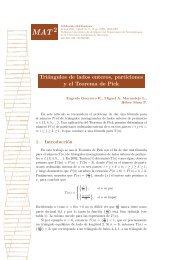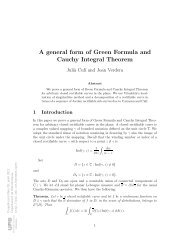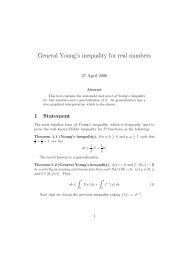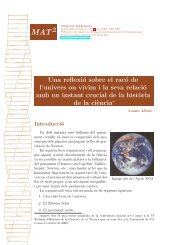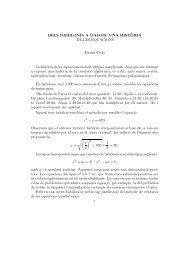ASPECTS OF IWASAWA THEORY OVER FUNCTION FIELDS 1 ...
ASPECTS OF IWASAWA THEORY OVER FUNCTION FIELDS 1 ...
ASPECTS OF IWASAWA THEORY OVER FUNCTION FIELDS 1 ...
Create successful ePaper yourself
Turn your PDF publications into a flip-book with our unique Google optimized e-Paper software.
<strong>IWASAWA</strong> <strong>THEORY</strong> <strong>OVER</strong> <strong>FUNCTION</strong> <strong>FIELDS</strong> 212. if θ Fd /F,S is irreducible in Λ(F d ), then Ch Λ(Fd )(A(F d )) = (θ Fd /F,S) m for some m ≥ 1;3. if θ Fd /F,S is irreducible in Λ(F d ) for all F d ’s, then ˜Ch Λ (A(F)) = (θ F/F,S ) m for somem ≥ 1.Proof. For 1 one just notes that |F ∗ L| is prime with p. Part 2 follows from the structuretheorem for torsion Λ(F d )-modules. Part 3 follows from 2 by taking limits (as in Definition5.10) and noting that the m is constant through the F d ’s because of equations (5.14) and(5.16). □The exponent in 2 and 3 of the corollary above is actually m = 1. A proof of this fact isbased on the following technical result of [28] (generalized in [9, Theorem A.1]). Once F d isfixed it is always possible to find a Z c p-extension of F containing F d , call it L d , such that:a. the extension L d /F is ramified at all primes of a finite set ˜S containing S (moreover˜S can be chosen arbitrarily large);b. the Stickelberger element θ Ld /F, ˜S is irreducible in the Iwasawa algebra Λ(L d);c. there is a Z p -extension L ′ of F contained in L d which is ramified at all primes of ˜S andsuch that the Stickelberger element θ Lis monomial, i.e., congruent to u(σ − ′ 1)r/F, ˜Smodulo (σ − 1) r+1 (where σ is a topological generator of Gal(L ′ /F ) and u ∈ Z ∗ p ).With condition b and an iteration of equation (5.14) one proves thatCh Λ(Fd )(A(F d )) = (θ Fd /F,S) m for some m ≥ 1 .The monomiality condition c (using L ′ as a first layer in a tower of Z p -extensions) leads tom = 1 (see [27, section 4] or [9, section A.1] which uses the possibility of varying the set˜S, provided by a, more directly). We remark that the proof only uses the irreducibility ofθ Ld, i.e.,/F, ˜S(5.17) Ch Λ(Fd )(A(F d )) = (θ Fd /F,S)holds in general for any F d .Corollary 5.16 (Iwasawa Main Conjecture). In the previous setting we have˜Ch Λ (A(F)) = (θ F/F,p ) .Proof. From the main result of [27], one has thatand we take the limit in both sides.Ch Λ(Fd )(A(F d )) = (θ Fd /F,p)Remark 5.17. The equality between characteristic ideals and ideals generated by Stickelbergerelements has been proved by K.-L. Kueh, K. F. Lai and K.-S. Tan ([27]) and by D.Burns ([8] and the Appendix coauthored with K.F. Lai and K-S. Tan [9]) in a more generalsituation. The Z d p-extension they consider has to be unramified outside a finite set S of primesof F (but there is no need for the primes to be totally ramified). Moreover they require thatnone of the primes in S is totally split (otherwise θ Fd /F,S = 0). The strategy of the proofis basically the same but, of course, many technical details are simplified by our choice ofhaving just one (totally) ramified prime (just compare, for example, Lemma 5.7 with [27,Lemma 3.3 and 3.4]). Moreover, going back to the Fitting vs. characteristic ideal situation,it is worth noticing that Burns proves that the first cohomology group of certain complexes(strictly related to class groups, see [8, Proposition 4.4] and [9, section A.1]) are of projectivedimension 1 ([8, Proposition 4.1]). In this case the Fitting and characteristic ideals are knownto be equal to the inverse of the Knudsen-Mumford determinant (the ideal by which all theresults of [8] are formulated).□


